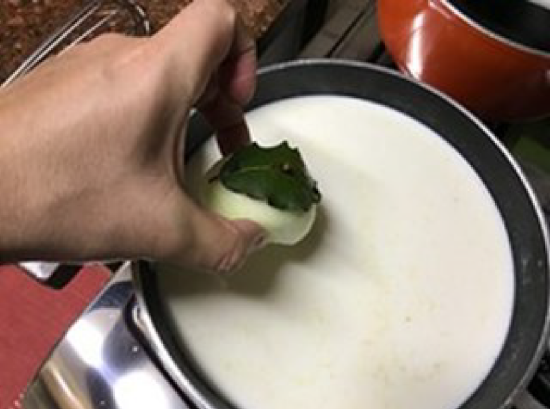1.5: Bechamel Based Sauces
- Page ID
- 21154
\( \newcommand{\vecs}[1]{\overset { \scriptstyle \rightharpoonup} {\mathbf{#1}} } \)
\( \newcommand{\vecd}[1]{\overset{-\!-\!\rightharpoonup}{\vphantom{a}\smash {#1}}} \)
\( \newcommand{\id}{\mathrm{id}}\) \( \newcommand{\Span}{\mathrm{span}}\)
( \newcommand{\kernel}{\mathrm{null}\,}\) \( \newcommand{\range}{\mathrm{range}\,}\)
\( \newcommand{\RealPart}{\mathrm{Re}}\) \( \newcommand{\ImaginaryPart}{\mathrm{Im}}\)
\( \newcommand{\Argument}{\mathrm{Arg}}\) \( \newcommand{\norm}[1]{\| #1 \|}\)
\( \newcommand{\inner}[2]{\langle #1, #2 \rangle}\)
\( \newcommand{\Span}{\mathrm{span}}\)
\( \newcommand{\id}{\mathrm{id}}\)
\( \newcommand{\Span}{\mathrm{span}}\)
\( \newcommand{\kernel}{\mathrm{null}\,}\)
\( \newcommand{\range}{\mathrm{range}\,}\)
\( \newcommand{\RealPart}{\mathrm{Re}}\)
\( \newcommand{\ImaginaryPart}{\mathrm{Im}}\)
\( \newcommand{\Argument}{\mathrm{Arg}}\)
\( \newcommand{\norm}[1]{\| #1 \|}\)
\( \newcommand{\inner}[2]{\langle #1, #2 \rangle}\)
\( \newcommand{\Span}{\mathrm{span}}\) \( \newcommand{\AA}{\unicode[.8,0]{x212B}}\)
\( \newcommand{\vectorA}[1]{\vec{#1}} % arrow\)
\( \newcommand{\vectorAt}[1]{\vec{\text{#1}}} % arrow\)
\( \newcommand{\vectorB}[1]{\overset { \scriptstyle \rightharpoonup} {\mathbf{#1}} } \)
\( \newcommand{\vectorC}[1]{\textbf{#1}} \)
\( \newcommand{\vectorD}[1]{\overrightarrow{#1}} \)
\( \newcommand{\vectorDt}[1]{\overrightarrow{\text{#1}}} \)
\( \newcommand{\vectE}[1]{\overset{-\!-\!\rightharpoonup}{\vphantom{a}\smash{\mathbf {#1}}}} \)
\( \newcommand{\vecs}[1]{\overset { \scriptstyle \rightharpoonup} {\mathbf{#1}} } \)
\( \newcommand{\vecd}[1]{\overset{-\!-\!\rightharpoonup}{\vphantom{a}\smash {#1}}} \)
\(\newcommand{\avec}{\mathbf a}\) \(\newcommand{\bvec}{\mathbf b}\) \(\newcommand{\cvec}{\mathbf c}\) \(\newcommand{\dvec}{\mathbf d}\) \(\newcommand{\dtil}{\widetilde{\mathbf d}}\) \(\newcommand{\evec}{\mathbf e}\) \(\newcommand{\fvec}{\mathbf f}\) \(\newcommand{\nvec}{\mathbf n}\) \(\newcommand{\pvec}{\mathbf p}\) \(\newcommand{\qvec}{\mathbf q}\) \(\newcommand{\svec}{\mathbf s}\) \(\newcommand{\tvec}{\mathbf t}\) \(\newcommand{\uvec}{\mathbf u}\) \(\newcommand{\vvec}{\mathbf v}\) \(\newcommand{\wvec}{\mathbf w}\) \(\newcommand{\xvec}{\mathbf x}\) \(\newcommand{\yvec}{\mathbf y}\) \(\newcommand{\zvec}{\mathbf z}\) \(\newcommand{\rvec}{\mathbf r}\) \(\newcommand{\mvec}{\mathbf m}\) \(\newcommand{\zerovec}{\mathbf 0}\) \(\newcommand{\onevec}{\mathbf 1}\) \(\newcommand{\real}{\mathbb R}\) \(\newcommand{\twovec}[2]{\left[\begin{array}{r}#1 \\ #2 \end{array}\right]}\) \(\newcommand{\ctwovec}[2]{\left[\begin{array}{c}#1 \\ #2 \end{array}\right]}\) \(\newcommand{\threevec}[3]{\left[\begin{array}{r}#1 \\ #2 \\ #3 \end{array}\right]}\) \(\newcommand{\cthreevec}[3]{\left[\begin{array}{c}#1 \\ #2 \\ #3 \end{array}\right]}\) \(\newcommand{\fourvec}[4]{\left[\begin{array}{r}#1 \\ #2 \\ #3 \\ #4 \end{array}\right]}\) \(\newcommand{\cfourvec}[4]{\left[\begin{array}{c}#1 \\ #2 \\ #3 \\ #4 \end{array}\right]}\) \(\newcommand{\fivevec}[5]{\left[\begin{array}{r}#1 \\ #2 \\ #3 \\ #4 \\ #5 \\ \end{array}\right]}\) \(\newcommand{\cfivevec}[5]{\left[\begin{array}{c}#1 \\ #2 \\ #3 \\ #4 \\ #5 \\ \end{array}\right]}\) \(\newcommand{\mattwo}[4]{\left[\begin{array}{rr}#1 \amp #2 \\ #3 \amp #4 \\ \end{array}\right]}\) \(\newcommand{\laspan}[1]{\text{Span}\{#1\}}\) \(\newcommand{\bcal}{\cal B}\) \(\newcommand{\ccal}{\cal C}\) \(\newcommand{\scal}{\cal S}\) \(\newcommand{\wcal}{\cal W}\) \(\newcommand{\ecal}{\cal E}\) \(\newcommand{\coords}[2]{\left\{#1\right\}_{#2}}\) \(\newcommand{\gray}[1]{\color{gray}{#1}}\) \(\newcommand{\lgray}[1]{\color{lightgray}{#1}}\) \(\newcommand{\rank}{\operatorname{rank}}\) \(\newcommand{\row}{\text{Row}}\) \(\newcommand{\col}{\text{Col}}\) \(\renewcommand{\row}{\text{Row}}\) \(\newcommand{\nul}{\text{Nul}}\) \(\newcommand{\var}{\text{Var}}\) \(\newcommand{\corr}{\text{corr}}\) \(\newcommand{\len}[1]{\left|#1\right|}\) \(\newcommand{\bbar}{\overline{\bvec}}\) \(\newcommand{\bhat}{\widehat{\bvec}}\) \(\newcommand{\bperp}{\bvec^\perp}\) \(\newcommand{\xhat}{\widehat{\xvec}}\) \(\newcommand{\vhat}{\widehat{\vvec}}\) \(\newcommand{\uhat}{\widehat{\uvec}}\) \(\newcommand{\what}{\widehat{\wvec}}\) \(\newcommand{\Sighat}{\widehat{\Sigma}}\) \(\newcommand{\lt}{<}\) \(\newcommand{\gt}{>}\) \(\newcommand{\amp}{&}\) \(\definecolor{fillinmathshade}{gray}{0.9}\)The Bechamel Family
Balsamell or Besciamella is the Italian equivalent of the French Béchamel: a very simple white sauce of flour, butter and milk. The sauce was originally from Renaissance Tuscany and was known as "Salsa Colla or Colletta" ("glue sauce") because of the gluey consistency of the sauce, and was brought to France by the chefs of Catherina de' Medici in 1533. This sauce was prominent in Italian cooking texts of the Renaissance as "salsa colla", but was renamed much later in Le Cuisinier François, published in 1651 by François Pierre La Varenne (1615–1678).
Named for its creator, Louis de Béchamel (1630-1703), steward to Louis XIV of France, béchamel sauce is the easiest mother sauce to prepare. Traditionally, it is made by adding heavy cream to a thick veal veloute. Although some chefs still believe a béchamel should contain veal stock, today the sauce is generally made by thickening scalded milk with a white roux and adding seasonings. Often used for vegetable, egg and gratin dishes, béchamel has fallen into relative disfavor recently because of its rich, heavy nature. It is nevertheless important to understand its production and its place in traditional sauce making.
A properly made béchamel is rich, creamy and absolutely smooth with no hint of graininess. The flavors of the onion and clove used to season it should be apparent but not overwhelm the sauce's clean, milky taste. The sauce should be the color of heavy cream and have a deep luster. It should be thick enough to coat foods lightly bur should not taste like the roux used to thicken it.
Ingredients
Scalded Milk -to heat a liquid, usually milk, to just below boiling point. Boiling can cause the milk to curdle, which is not particularly appetizing. The milk separates and loses its emulsion which then will create the look of a broken sauce.
Onion Piquet - attach a bay leaf to a piece of onion by pushing whole cloves (like a toothpick) through the bay leaf into the onion. This is the classic seasoning for béchamel sauce. Clove is a spice that are flower buds from a tree. Very aromatic (May be considered as a Christmas Spice).

Example of an onion piquet. Photo Credit: Flikr
- Nutmeg - used sparingly and can be considered intrusive. Also a Christmas spice.
- White Roux - Barely cooked and has the most thickening power. Can be made with butter to added flavor since it is not cooked very long.
| Sauce | Qualities | Small Sauce or Flavorings | Use |
|---|---|---|---|
| Béchamel | Smooth, rich and creamy; no graininess; cream- colored with rich sheen | Cream | Vegetables, pasta, eggs, fish, shellfish |
| Cheese | Vegetables, pasta | ||
| Mornay | Fish, shellfish, poultry, vegetables | ||
| Nantua | Fish, shellfish | ||
| Soubise | Veal, pork, eggs |
Ingredients in Derivatives and Troubleshooting
- Cheese - can cause a bechamel to curdle because it can separate if heated to high. That is why it is usually slightly melted at the end
- Mustard - can cause curdling because of the acid in it.
- Horseradish - can cause curdling because of the acid in it.
- Lemon – can cause curdling because it is an acid.
- Mushrooms - add water, and may make the sauce watery if not sautéed before.
- Corn - is a starch and can cause additional thickening.
- Crawfish - can change the color or can become over cooked.
- Onions - add sweetness.
- Smoking flavor - too much/too little-could be considered an intrusive ingredient.
Factors affecting NAPPE
- Reducing too much
- Reducing too little
- Letting a sauce stand
- Refrigerating
- Other ingredients added to the sauce
All of the above notes can affect the consistency of a bechamel. Remember this is a tricky sauce because it can become easily gloopy or too thick.
A proper béchamel should be:
- Rich and Smooth
- With no hint of graininess
- You should not taste the roux
- When used as a sauce it should be thick enough to lightly coat the food.
Yield: 1 gal. (4 lt)
- Onion piquet 1 (1)
- Milk 1 gal. (4 lt)
- Flour 8 oz. (250 g)
- Clarified butter 8 fl. oz. (250 ml)
- Salt and white pepper TT (TT)
- Nutmeg TT (TT)
- Tack a bay leaf onto a small peeled onion using a clove to make onion piquet. Add the onion piquet to the milk in a heavy saucepan and simmer for 20 minutes.
- In a separate pot, make a white roux with the flour and butter.
- Remove the onion piquet from the milk.
- Gradually add the hot milk to the roux while stirring constantly with a whisk to prevent lumps. Bring to a boil.
- Reduce the sauce to a simmer, add the seasonings and continue cooking for 30 minutes.
- Strain the sauce through a china cap lined with cheesecloth. Carefully ladle melted butter over the surface of the sauce to prevent a skin from forming. Hold for service or cool in a water bath.
Small (Daughter) Sauces
With a good béchamel, producing the small sauces in its family is quite simple. The quantities given are for 1 quart (l liter) of béchamel. The final step for each recipe is to season to taste with salt and pepper.
- CREAM SAUCE - Add to béchamel 8-12 fluid ounces (250-360 milliliters) scalded cream and a few drops of lemon juice.
- CHEESE - Add to béchamel 8 ounces (250 grams) grated Cheddar or American cheese, a clash of Worcestershire sauce and 1-tablespoon (15 milliliters) city mustard.
- MORNAY - Add to béchamel 4-ounces (120 grams) grated Gruyere and 1 ounce (30 grams) grated Parmesan. Thin as desired with scalded cream. Remove the sauce from the heat and swirl in 2-ounces (60 grams) whole butter.
- NANTUA - Add to béchamel 4 fluid ounces (120 milliliters) heavy cream and 6-ounces (180 grams) crayfish butter. Add paprika to achieve the desired color. Garnish the finished sauce with d iced crayfish meat.
- SOUBISE (MODERN) - Sweat one pound (500 grams) diced onions in 1-ounce (30 grams) whole butter without browning. Adel béchamel and simmer until the onions are fully cook ed. Strain through a fine chinois.


Bechamel sauce plate up examples. Photo Credit: Amelie Zeringue


